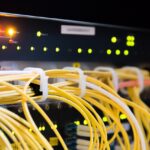What is an IP address in simple terms?

January 17, 2023
An IP address, also known as an Internet Protocol address, is a string of numbers that uniquely identifies any device on a network. IP addresses are used by computers to communicate with one another on the internet and other networks. The internet protocols manage the process of assigning an IP address to each unique device. (Internet protocols also perform other functions, such as routing internet traffic.) This makes it simple to see which internet devices are sending, requesting, and receiving data.
IP addresses are similar to phone numbers in that they serve the same purpose. When you call someone, your phone number identifies you and assures the person answering the phone that you are who you say you are.
The components of your IP address
An IP address is divided into two parts: the network ID (the first three numbers of the address) and the host ID (the fourth number in the address). On your home network, for example, 192.168.1.1, 192.168.1 is the network ID, and the final number is the host ID.
The Network ID identifies which network the device is connected to. The Host ID identifies a specific device on that network. (Typically, your router is.1, and each subsequent device is assigned. 2,.3, and so forth.)
You might not always want the rest of the world to know which device and network you’re using. In this case, a Virtual Private Network (VPN) can be used to conceal your IP address from the outside world (VPN). When you use a VPN, your network is prevented from revealing your IP address.
Where do IP addresses originate?
IPv4 dates back to the early 1980s, when the internet was a private military network. IPv4 has a total address pool of 4.3 billion, which appears to be a large number. However, with all of the computers, smartphones, and tablets that connect to the internet, not to mention IoT devices, we have reached the limit of IPv4 addresses. In fact, we started running out of supplies in the 1990s. Technical networking at its finest.
IPv6 was developed about a decade ago by the Internet Engineering Task Force (IETF), which designs the internet’s backbone technologies. It has a potential pool of 340 undecillion addresses — that’s 340 followed by 36 zeroes — which means we’ll never run out of addresses (in theory). It is gradually replacing IPv4, but for the time being, the two coexist.
Public versus private IP addresses
IP addresses are classified into two types: external, or public IP addresses, and internal, also known as local or private addresses. Your external address is provided by your internet service provider (ISP). When you visit a website, the site needs to know who you are (for traffic-monitoring reasons). Your ISP introduces using your external IP address.
How do IP addresses function?
The post office uses your physical address to identify a person, residence, or business’s physical location. It is how mail is delivered. It is where you live. It tells others where to find you.
In a digital sense, all of these descriptions apply to an IP address. In a virtual sense, an IP address is where a computer resides. IP addresses can be used to identify a computer, a website, a network server, or even a device (such as a webcam).
IP addresses are particularly important for sending and receiving data. They direct email to your inbox and route internet traffic where it needs to go.





